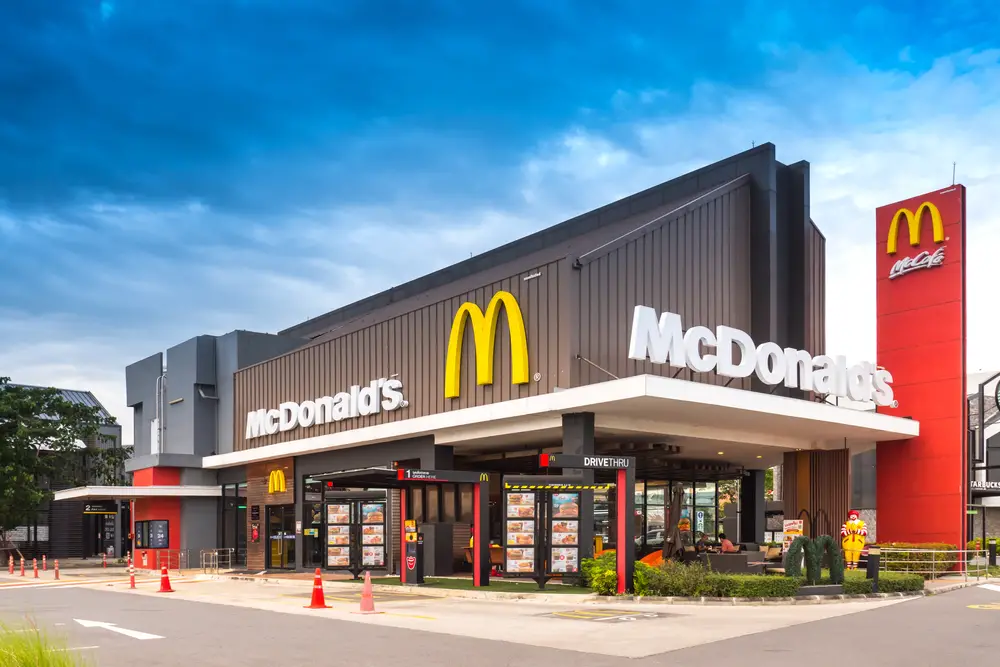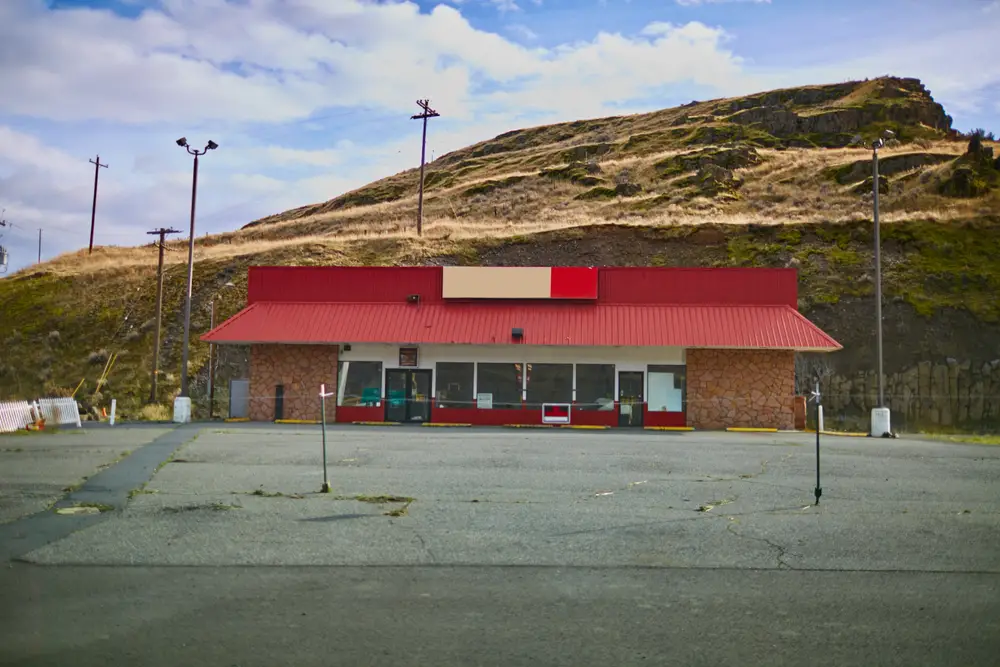In the world of fast food, McDonald’s has long been associated with bustling urban locations and busy thoroughfares. However, the narrative took a curious turn with the recent opening of a McDonald’s store in a rather unexpected setting – the heart of the countryside. Nestled at 8075 Avenue Marcel-Villeneuve in Saint-François, Laval, Quebec, Canada, this new McDonald’s establishment has become the talk of the town, or rather, the fields.
Social Media Unveiling: TikTok’s Role in the McDonald’s Saga
The unorthodox setting of McDonald’s latest outpost took center stage thanks to the power of social media, with TikTok emerging as the primary platform for the revelation. In a digital age where information travels at the speed of a click, user @thumbs.up.canuck played a pivotal role in bringing this McDonald’s anomaly to the global spotlight.

Viral Footage: A Fast-Food Surprise Amidst Fields
The unfolding of this McDonald’s mystery was captured in a video shared by the TikTok user, offering viewers an unprecedented glimpse into the fast-food giant’s unexpected rural abode.
The footage showcased the restaurant standing alone in the midst of a vast farm field, a stark departure from the conventional urban landscapes associated with McDonald’s. The unexpectedness of the location was accentuated by the absence of any basic urban amenities, raising eyebrows and generating intrigue among the online audience.
The TikTok video swiftly achieved viral status, with users across the platform engaging in discussions and speculations and sharing their diverse theories about why McDonald’s chose such an unconventional location.
The absence of traditional infrastructure, such as a connection to the electrical grid, stood out prominently. The revelation spurred a virtual storm of curiosity, turning a simple video into a catalyst for a broader conversation about the strategic thinking behind McDonald’s foray into the rural landscape.
Rural Generator Reliance: Illuminating the Unusual Setup
The video shed light on the peculiar conditions under which McDonald’s operates, relying on generators to power its day-to-day functions. This added layer of peculiarity further fueled the public’s fascination, prompting questions about the feasibility and sustainability of such an unusual setup. The reliance on generators, in contrast to the ubiquitous urban connection to the power grid, added to the mystique surrounding this fast-food establishment.
As the video circulated and discussions unfolded, various theories emerged regarding the motive behind choosing such a unique location. From strategic long-term planning to potential land development, users speculated on the reasons driving McDonald’s to establish a presence in the heart of the countryside. The TikTok revelation not only showcased the peculiar setting but also ignited a digital discourse that transcended geographic boundaries, turning McDonald’s into a global talking point.
In the age of social media influence, this TikTok revelation stands as a testament to the digital era’s ability to transform everyday occurrences into international phenomena, unraveling the mysteries behind a fast-food giant’s unconventional choice of locale.
Franchisee’s Vision: Jérémy Lévy’s Commitment to Community Ties

The narrative surrounding McDonald’s unconventional venture in Saint-François, Laval, gains depth and nuance with the insights provided by Jérémy Lévy, the franchisee steering this atypical fast-food journey. As a key player in this mysterious McDonald’s saga, Lévy’s perspective sheds light on the community-centric approach adopted by this particular franchise.
Generational Legacy: A McDonald’s Family Connection
Jérémy Lévy’s journey as a McDonald’s franchisee is not just a professional endeavor but a continuation of a familial legacy. With his father being a McDonald’s franchisee as well, Lévy brings a generational connection to the brand, understanding the intricate dynamics that go beyond the business aspects. This family tie to McDonald’s unveils a personal investment in the success and impact of this restaurant on the local community.
In a notable statement, Lévy expressed his excitement about stepping into his father’s shoes and actively engaging with the Saint-François community. This declaration goes beyond the standard rhetoric of a business announcement; it reflects a genuine eagerness to be a part of the local milieu. Lévy’s words become a symbol of the franchisee’s commitment to weaving McDonald’s into the social fabric of Saint-François.
Community Engagement as a Pillar: Beyond Fast Food
Lévy’s emphasis on following in his father’s footsteps extends beyond the operational aspects of running a McDonald’s franchise. It underscores a dedication to community engagement—a fundamental aspect that has contributed to McDonald’s success in various locations globally.
This unconventional outpost is not merely a fast-food establishment; it emerges as an initiative to be a contributing member of the community, adding a layer of social responsibility to the usual expectations from a McDonald’s branch.
The franchisee’s commitment hints at the potential transformation of this McDonald’s into more than just a place to grab a quick meal. Instead, it becomes a potential hub for community interactions, gatherings, and events. By integrating into the local scene, McDonald’s, under Lévy’s stewardship, aspires to bridge gaps and create a space that resonates with the unique identity of Saint-François.
Jérémy Lévy’s role in this McDonald’s venture transcends the usual expectations, embodying a vision that sees the golden arches not just as a symbol of fast food but as a connector of communities. As this saga unfolds, Lévy’s commitment to community integration becomes a compelling chapter in the story of McDonald’s in the heart of the countryside.
Deciphering the Riddle: McDonald’s Strategic Moves
While the rural placement of McDonald’s in Saint-François, Laval is undeniably intriguing, there are plausible reasons that could illuminate the motivations behind this unexpected move:
- Strategic Vision for Future Development: McDonald’s Corporation may be playing a strategic long-term game, anticipating forthcoming urban development plans that could increase the local population. By establishing a presence now, the fast-food giant could position itself strategically for future growth.
- Market Research and Rural Outreach: Renowned for meticulous market research, McDonald’s might be testing the waters in a literal sense. The company could be gauging the interest and response of consumers in a rural demographic, exploring the viability of serving customers in less traditional locations.
- Embracing Natural Serenity: Another perspective suggests that McDonald’s is embracing the charm of the countryside. By situating itself amidst natural surroundings, the fast-food giant might be positioning this outlet as a unique dining destination, offering an alternative experience to those seeking a break from the chaos of urban life.
The Enigmatic Future: Unveiling McDonald’s Saint-François Odyssey
The anticipation surrounding McDonald’s enigmatic outpost in Saint-François, Laval, becomes more palpable as speculation looms over the purpose and future trajectory of this rural fast-food venture. The lack of clarity surrounding its existence serves as a catalyst for intrigue, fostering a sense of curiosity and inquiry among both the local community and a wider audience.
Speculations and Conversations: Unraveling the Mystery
The conspicuous choice of a rural setting has fueled discussions and speculations about the potential motivations behind McDonald’s decision. The absence of conventional urban amenities, such as a stable electricity supply, intensifies the mystery.
Social media, particularly the viral TikTok video by @thumbs.up.canuck, has become a platform for shared theories and hypotheses. This digital discourse has further amplified the intrigue, creating a virtual space where the public collectively contemplates the purpose of this fast-food oasis in the countryside.
Theories abound regarding the purpose of McDonald’s in Saint-François. One plausible explanation could be rooted in a long-term strategic vision. The corporation may foresee potential urban development plans for the surrounding area, positioning the fast-food giant ahead of an anticipated surge in local population and subsequent demand for quick dining options.
Market Testing in Uncharted Territories: A McDonald’s Experiment?
Another perspective revolves around McDonald’s commitment to market research and catering to diverse consumer demands. Placing a McDonald’s in an unexpected rural location could be an intentional move to gauge the market’s response. The fast-food chain might be exploring the potential success of serving customers from a more rural demographic, unveiling a new chapter in its quest for adaptability and relevance.
Beyond strategic and market-driven motives, McDonald’s might be embracing the charm of the countryside. Positioning itself as a unique dining destination for those seeking a respite from urban life, the fast-food establishment could be tapping into an untapped market segment. By providing a serene environment amidst nature, McDonald’s may be redefining its identity and inviting customers to experience fast food in a distinctive setting.
As the McDonald’s saga in Saint-François unfolds, the lack of clarity surrounding its future only adds to the allure. Will this rural outpost transform into a community hub, connecting residents in unexpected ways? Or is it a strategic move preceding broader urban development? The enigma deepens, leaving the public in suspense and ensuring that McDonald’s in the heart of the countryside remains a fascinating subject of contemplation and speculation.
Rural Renaissance: McDonald’s and Community Bonding
McDonald’s strategic placement in Saint-François transcends traditional notions of fast-food establishments, hinting at a nuanced approach to community integration. This section delves deeper into the potential role of McDonald’s in fostering community bonding within the rural landscapes of Saint-François.
Connecting Beyond Consumption: A Social Hub in the Countryside
In contemplating the broader significance of McDonald’s in rural settings, the prospect of it evolving into a social hub becomes increasingly intriguing. Beyond being a mere purveyor of fast food, McDonald’s could redefine its role as a communal space. In this modern-day agora, residents gather not only for meals but for shared experiences.

The absence of traditional community spaces often leaves rural areas devoid of a central meeting point. This McDonald’s, nestled in the heart of Saint-François, could fill this void, emerging as a hub for social interaction. Picture locals catching up over coffee, exchanging news, or even using the restaurant as a venue for community events. This unexpected transformation could turn McDonald’s into an integral part of the social fabric, symbolizing more than just a place for fast food.
Local Employment and Economic Impact: A Win-Win Proposition
Beyond the realm of social dynamics, the economic implications of this venture hold immense potential. The creation of a McDonald’s in Saint-François could go beyond providing a convenient dining option—it might be a catalyst for local employment and economic growth. McDonald’s has a proven track record of generating jobs, from managerial roles to front-line positions.
By becoming a source of employment within the community, McDonald’s could inject vitality into Saint-François. As residents find employment opportunities within the establishment, it creates a mutually beneficial relationship. The fast-food giant, in turn, becomes more than just a commercial entity; it becomes a contributor to the local economy. This symbiotic relationship between McDonald’s and the community lays the foundation for a shared journey where both parties thrive.
As Saint-François navigates the uncharted waters of having a McDonald’s in its midst, the potential for this fast-food giant to evolve into a catalyst for community bonding and economic prosperity becomes an exciting prospect. McDonald’s, usually associated with global consumerism, could, in this rural setting, redefine its role as a force for positive change at the local level.
Sustainability in the Countryside: McDonald’s Green Initiative
Amidst the fields of Saint-François, McDonald’s may find an unexpected opportunity to champion sustainability. The rural setting presents a unique canvas for implementing green initiatives that align with the ethos of responsible business practices. This section explores the potential for McDonald’s to embrace sustainability in this unconventional location.
Farm-to-Table: A Locally Sourced Approach
In a departure from conventional practices, this rural McDonald’s could explore a farm-to-table approach, sourcing ingredients locally. Collaborating with nearby farmers and suppliers, the fast-food giant can create a menu that reflects the agricultural richness of the region. Not only does this support local businesses, but it also reduces the carbon footprint associated with transportation, aligning with contemporary sustainability trends.
Green Energy and Waste Management: Eco-Friendly Operations
Operating in an off-grid manner with generators, McDonald’s can leverage green energy solutions. Incorporating solar panels or exploring wind energy options aligns with the trend towards eco-friendly practices. Additionally, waste management initiatives, such as composting and recycling programs, can minimize the environmental impact of fast-food operations. McDonald’s, traditionally seen as a symbol of consumerism, could surprise the world by becoming a beacon of sustainability in the countryside.
Pondering The McDonald’s Odyssey
The enigmatic McDonald’s store in Saint-François, Laval, stands as a testament to the brand’s ability to surprise and captivate. As the public’s curiosity grows, one can only speculate about the long-term vision that propels McDonald’s to venture into uncharted territories. The seemingly unusual choice of location has not only ignited discussions but has also underscored the brand’s innovative spirit, leaving us all eager to see what unfolds next in this rural fast-food odyssey.
Sources:
The unexpectedness of the location was accentuated by the absence of any basic urban amenities.
This outpost adds a layer of social responsibility to the usual expectations from a McDonald’s branch.
The anticipation becomes more palpable as speculation looms over the future of this rural fast-food venture.
The fast-food establishment could be tapping into an untapped market segment.

This Site Was Inspired By An Interest in Protecting the Environment:
We had the privilege and joy of learning from Dr. Charlie Stine who instilled a love for the natural world through incredible field trips with the Johns Hopkins Odyssey Certificate program in Environmental Studies. At the time, the program was endorsed by the Maryland Department of Natural Resources. Sadly, after Dr. Stine retired, the program was phased out. We hope that we honor his legacy by shining a bright light on environmental issues and sharing good news about the success of various conservation programs when possible.

